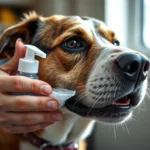
Introduction
Discoid Lupus Erythematosus (DLE) is an autoimmune disease that primarily affects the skin of dogs. This condition can lead to significant discomfort and distress for our furry companions, making it essential for dog owners to be aware of its symptoms and management. Understanding DLE is crucial because early detection can significantly improve the quality of life for affected dogs. This article aims to provide a comprehensive overview of DLE in dogs, covering its causes, symptoms, diagnosis, treatment options, and long-term management strategies.
Understanding Discoid Lupus Erythematosus (DLE)
What is Discoid Lupus Erythematosus?
DLE is a specific type of lupus that manifests primarily on the skin rather than affecting internal organs. As an autoimmune disease, it occurs when the immune system mistakenly attacks the body’s own healthy cells. In the case of DLE, the immune response targets skin cells, leading to inflammation and lesions. This can result in various skin abnormalities, particularly in sun-exposed areas.
Causes of DLE
The exact cause of DLE in dogs is not fully understood, but several factors may contribute:
- Genetic Predisposition: Certain breeds appear to be more susceptible to DLE, suggesting a hereditary component.
- Environmental Factors: Exposure to certain chemicals or allergens may trigger or exacerbate the condition.
- Role of UV Light Exposure: Dogs with DLE often show increased sensitivity to ultraviolet (UV) light, leading to flare-ups when exposed to sunlight.
Breeds Predisposed to DLE
Some dog breeds are more commonly affected by DLE. These include:
- Collies
- German Shepherds
- Siberian Huskies
- Shetland Sheepdogs
- Labrador Retrievers
While purebreds are often at higher risk, mixed breeds can also develop DLE. Therefore, all dog owners should remain vigilant regardless of their pet’s breed.
Symptoms of DLE in Dogs
Common Symptoms
The symptoms of DLE in dogs can vary in severity, but common signs include:
- Skin lesions: These often appear around the nose, eyes, and ears, characterized by redness and inflammation.
- Changes in pigmentation: Affected areas may become lighter or darker than the surrounding skin.
- Crusting and scaling: The skin may develop crusty patches, leading to discomfort and irritation.
Progression of Symptoms
Initially, symptoms might be mild and easily overlooked. However, if left untreated, they can progress to more severe forms. Early signs may include slight redness or scaling, while advanced stages can lead to severe lesions and significant hair loss. Early detection of these symptoms is crucial for effective treatment.
Behavioral Changes
Dogs with DLE may exhibit changes in behavior due to discomfort or pain. For instance, they may become less active, show reluctance to engage in play, or even display signs of anxiety. Owners should monitor their pets closely for any behavioral shifts that may indicate a health issue.
Diagnosis of DLE
Veterinary Assessment
If you notice any symptoms of DLE in dogs, it’s essential to consult a veterinarian. A thorough physical examination is necessary to assess the extent of the condition and rule out other potential issues.
Diagnostic Tests
To confirm a diagnosis of DLE, veterinarians may recommend the following tests:
- Skin Biopsy: This is often the definitive test for DLE. A small sample of the affected skin is examined microscopically to identify specific cellular changes associated with the disease.
- Blood Tests: These may be performed to rule out other autoimmune diseases or conditions that could mimic DLE symptoms.
Differential Diagnosis
Several conditions may present similarly to DLE, making accurate diagnosis crucial. Some of these include:
- Bacterial infections
- Other autoimmune skin diseases (such as pemphigus)
- Allergic dermatitis
Differentiating between these conditions often requires a combination of physical examination and diagnostic testing.
Treatment Options for DLE
Medications
Management of DLE in dogs often involves medication. Common options include:
- Corticosteroids: These anti-inflammatory drugs can reduce symptoms and flare-ups. Dosage and type will depend on the severity of the condition and the veterinarian’s recommendations.
- Immunosuppressive Drugs: In more severe cases, medications that suppress the immune response may be necessary. These include drugs like azathioprine or cyclosporine.
Topical Treatments
Topical treatments can be beneficial for localized lesions. Options include:
- Creams and ointments: These can help soothe and heal affected areas.
- Sunscreens: Dogs with DLE are particularly sensitive to UV light, so applying a pet-safe sunscreen to exposed areas can prevent flare-ups.
Lifestyle Changes
In addition to medication, certain lifestyle changes can help manage DLE:
- Reducing UV Exposure: Keeping dogs indoors during peak sunlight hours or providing shaded areas can protect them from harmful UV rays.
- Balanced Diet and Supplements: A well-rounded diet rich in omega-3 fatty acids may help support skin health and immune function.
Long-term Management of DLE
Regular Veterinary Check-ups
Ongoing veterinary care is essential for dogs with DLE. Regular check-ups allow for monitoring of the condition and adjustments to treatment plans as needed. This proactive approach can help manage symptoms effectively over time.
Home Care Strategies
Dog owners play a crucial role in managing DLE at home. Here are some tips:
- Monitor for Flare-ups: Be vigilant for any changes in your dog’s skin condition and behavior.
- Maintain a Clean Environment: Regular grooming can help prevent secondary infections and keep the skin healthy.
Support for Dog Owners
Caring for a dog with a chronic condition like DLE can be challenging. Owners may benefit from connecting with others in similar situations through online forums or support groups. Sharing experiences and tips can provide emotional support and practical advice.
FAQs About DLE
Common Questions
Can DLE be cured?
Currently, there is no cure for DLE in dogs. However, with proper treatment and management, many dogs lead happy, normal lives.
Is DLE contagious?
No, DLE is not contagious. It is an autoimmune disease, meaning it cannot be passed from one dog to another.
What can I do if my dog has a flare-up?
If your dog experiences a flare-up, consult your veterinarian immediately. They may recommend adjustments to the treatment plan or additional medications.
Expert Opinions
Veterinarians emphasize the importance of early detection and consistent management. They encourage dog owners to be proactive about monitoring their pets and seeking veterinary care at the first signs of trouble.
Conclusion
Discoid Lupus Erythematosus (DLE) is a significant autoimmune condition that affects many dogs, yet with proper understanding and management, it can be effectively controlled. Early recognition of symptoms, prompt veterinary diagnosis, and appropriate treatment can greatly enhance your dog’s quality of life. As a responsible pet owner, staying informed about DLE in dogs and maintaining open communication with your veterinarian can make all the difference in managing this chronic condition.









